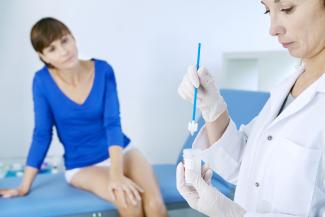
What’s going on down under? Dr Shital Raval has all the answers on vaginal health - from vaginal discharge to vaginal infections and yeast infections.
Is all vaginal discharge bad?
NO, a clear, or watery discharge anytime during the month is normal. Around the ovulation period, this discharge or cervical mucus may become thicker and stickier. This is normal and aids as a lubricant during sexual intercourse.
Coloured discharge or abnormal looking discharge accompanied by foul odor is usually indicative of an infection and must be checked out.
I have yellowish-green discharge. What does it mean?
A yellowish-green discharge that is thick in consistency and accompanied by a foul smell is usually seen in a trichomoniasis infection. Trichomonas vaginalis is a protozoan parasite that usually spreads by sexual contact, but can also be contracted by sharing towels or bathing suits. Typical symptoms include the coloured discharge, foul odor, painful urination, inflammation and genital itching.
It’s best to refrain from sexual activity till the infection has cleared. Your doctor will prescribe metronidazole or tinidazole for treatment. Your sexual partner should also be prescribed medication because he/she may be an asymptomatic carrier.
What is bacterial vaginosis? What are its symptoms?
Bacterial vaginosis (BV) is an infection of the vagina. It occurs when “bad” bacteria exceed the normal flora or “good” bacteria present in the vagina. It commonly affects women aged 15-44 years. Multiple sex partners or a new sex partner, and douching can upset the balance of bacteria in the vagina and increase the risk for getting BV. It may also affect women who have never had sex. Although not considered an STD, BV can increase your chances of getting an STD.
Symptoms may include vaginal itching or burning during urination, thin grayish white discharge, or foul-smelling "fishy" vaginal odour (especially after sexual intercourse).
What is yeast infection?
Most yeast infections are caused by a type of yeast called Candida albicans. Some yeast cells are normally present in a healthy vagina. Certain risk factors (listed below) can cause an imbalance of these cells causing them to grow and infect the area.
It presents with a thick, clumpy, cottage cheese-like white discharge that has no odour but itching, soreness, pain or burning during urination or sex. Most yeast infections subside with an anti-fungal cream, pills or suppository. If you have more than 4 yeast infections in a year, make sure you inform your doctor about it. Also if there is high fever, lower abdominal pain, you must see your doctor immediately.
What are the common risk factors for a yeast infection?
There are several risk factors that can increase the chances of developing an infection:
Antibiotics: Most antibiotics kill a wide variety of bacteria, including those that normally live in the vagina. These bacteria protect the vagina from the overgrowth of yeast.
Weak immunity: Yeast infections are more common in people who have a weakened immune system due to HIV or use of certain medications (steroids, chemotherapy, post-organ transplant medications).
Hormonal contraceptives: Women who use birth control methods containing oestrogen, such as birth control pills, patch, and vaginal ring have increased risk.
Contraceptive devices: Vaginal sponges, diaphragms, and intrauterine devices(IUDs) may increase the risk of yeast infections. Spermicides do not usually cause yeast infections, but can cause you to have vaginal or vulvar irritation.
Pregnancy: Causes rise in oestrogen levels and can be the cause for more yeast infections during pregnancy.
Sexual activity: It is not a sexually transmitted infection but can be transmitted during sex. It’s more common in women who are sexually active, but can also occur in women who have never been sexually active.
Diabetes: Women with diabetes are at higher risk for yeast infections, especially if their diabetes is uncontrolled or untreated.
Are there any home remedies for vaginal infections?
Clean the area with a mild soap and water.
Keep it dry by wearing loose cotton underwear. Avoid tight pants or jeans
Avoid scratching and apply calamine or aloe vera lotion for itch relief.
Avoid all vaginal hygiene products such as fragrant soaps, bubble baths or bath oils, and perfumed products.
After going to the bathroom, always wipe from front to back to prevent bacteria from getting into the vagina.
Additionally, eating yoghurt can increase the normal flora of good bacteria and help combat the infection.
If any of the symptoms worsen or don’t subside in 7 days, make sure you consult your doctor for further evaluation.






